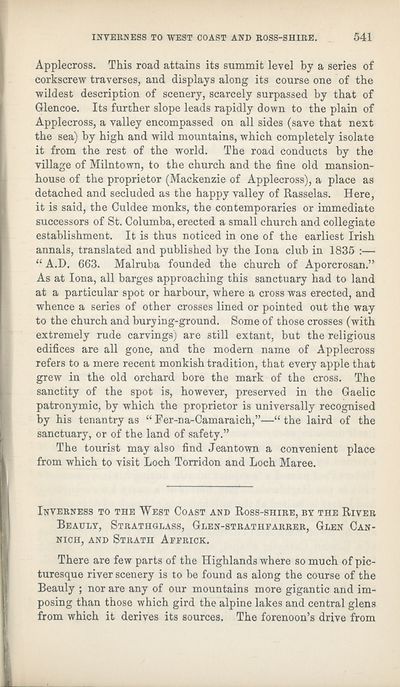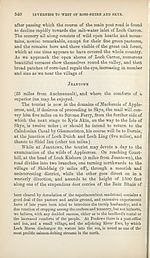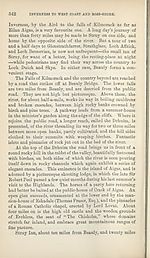Download files
Complete book:
Individual page:
Thumbnail gallery: Grid view | List view

INVERNESS TO WEST COAST AND ROSS-SHIRE.
541
Applecross. This road attains its summit level by a series of
corkscrew traverses, and displays along its course one of the
wildest description of scenery, scarcely surpassed by that of
Glencoe. Its further slope leads rapidly down to the plain of
Applecross, a valley encompassed on all sides (save that next
the sea) by high and wild mountains, which completely isolate
it from the rest of the world. The road conducts by the
village of Milntown, to the church and the fine old mansion-
house of the proprietor (Mackenzie of Applecross), a place as
detached and secluded as the happy valley of Rasselas. Here,
it is said, the Culdee monks, the contemporaries or immediate
successors of St. Columba, erected a small church and collegiate
establishment. It is thus noticed in one of the earliest Irish
annals, translated and published by the Iona club in 1835 :—
“ A.D. 663. Malruba founded the church of Aporcrosan.”
As at Iona, all barges approaching this sanctuary had to land
at a particular spot or harbour, where a cross was erected, and
whence a series of other crosses lined or pointed out the way
to the church and burying-ground. Some of those crosses (with
extremely rude carvings) are still extant, but the religious
edifices are all gone, and the modem name of Applecross
refers to a mere recent monkish tradition, that every apple that
grew in the old orchard bore the mark of the cross. The
sanctity of the spot is, however, preserved in the Gaelic
patronymic, by which the proprietor is universally recognised
by his tenantry as “ Fer-na-Camaraich,”—“ the laird of the
sanctuary, or of the land of safety.”
The tourist may also find Jeantown a convenient place
from which to visit Loch Torridon and Loch Maree.
Inverness to the West Coast and Ross-shire, by the River
Beauly, Strathglass, Glen-strathparrer, Glen Can-
nich, and Strath Affrick.
There are few parts of the Highlands where so much of pic¬
turesque river scenery is to be found as along the course of the
Beauly ; nor are any of our mountains more gigantic and im¬
posing than those which gird the alpine lakes and central glens
from which it derives its sources. The forenoon’s drive from
541
Applecross. This road attains its summit level by a series of
corkscrew traverses, and displays along its course one of the
wildest description of scenery, scarcely surpassed by that of
Glencoe. Its further slope leads rapidly down to the plain of
Applecross, a valley encompassed on all sides (save that next
the sea) by high and wild mountains, which completely isolate
it from the rest of the world. The road conducts by the
village of Milntown, to the church and the fine old mansion-
house of the proprietor (Mackenzie of Applecross), a place as
detached and secluded as the happy valley of Rasselas. Here,
it is said, the Culdee monks, the contemporaries or immediate
successors of St. Columba, erected a small church and collegiate
establishment. It is thus noticed in one of the earliest Irish
annals, translated and published by the Iona club in 1835 :—
“ A.D. 663. Malruba founded the church of Aporcrosan.”
As at Iona, all barges approaching this sanctuary had to land
at a particular spot or harbour, where a cross was erected, and
whence a series of other crosses lined or pointed out the way
to the church and burying-ground. Some of those crosses (with
extremely rude carvings) are still extant, but the religious
edifices are all gone, and the modem name of Applecross
refers to a mere recent monkish tradition, that every apple that
grew in the old orchard bore the mark of the cross. The
sanctity of the spot is, however, preserved in the Gaelic
patronymic, by which the proprietor is universally recognised
by his tenantry as “ Fer-na-Camaraich,”—“ the laird of the
sanctuary, or of the land of safety.”
The tourist may also find Jeantown a convenient place
from which to visit Loch Torridon and Loch Maree.
Inverness to the West Coast and Ross-shire, by the River
Beauly, Strathglass, Glen-strathparrer, Glen Can-
nich, and Strath Affrick.
There are few parts of the Highlands where so much of pic¬
turesque river scenery is to be found as along the course of the
Beauly ; nor are any of our mountains more gigantic and im¬
posing than those which gird the alpine lakes and central glens
from which it derives its sources. The forenoon’s drive from
Set display mode to:
![]() Universal Viewer |
Universal Viewer | ![]() Mirador |
Large image | Transcription
Mirador |
Large image | Transcription
| Antiquarian books of Scotland > Scotland/Scots > Black's picturesque tourist of Scotland > (675) |
|---|
| Permanent URL | https://digital.nls.uk/130036290 |
|---|
| Description | Thousands of printed books from the Antiquarian Books of Scotland collection which dates from 1641 to the 1980s. The collection consists of 14,800 books which were published in Scotland or have a Scottish connection, e.g. through the author, printer or owner. Subjects covered include sport, education, diseases, adventure, occupations, Jacobites, politics and religion. Among the 29 languages represented are English, Gaelic, Italian, French, Russian and Swedish. |
|---|

